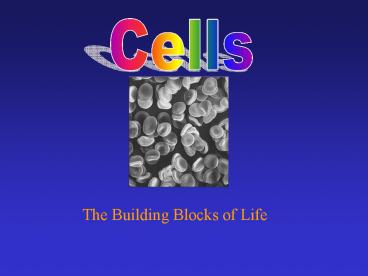The Building Blocks of Life - PowerPoint PPT Presentation
1 / 17
Title:
The Building Blocks of Life
Description:
The Building Blocks of Life TODAY: Cell Structure and Function What are the common features of all cells? What is the difference between prokaryotic and eukaryotic ... – PowerPoint PPT presentation
Number of Views:307
Avg rating:3.0/5.0
Title: The Building Blocks of Life
1
Cells
- The Building Blocks of Life
2
Cells are Us
A person contains about 100 trillion cells.
Thats 100,000,000,000,000 or 1 x 1014 cells.
There are about 200 different cell types in
mammals (one of us).
Cells are teeny, tiny, measuring on average about
0.002 cm (20 um) across. Thats about 1250 cells,
shoulder-to-shoulder per inch.
3
Why Study Cell Biology?
The key to every biological problem must finally
be sought in the cell, for every living organism
is, or at some time has been, a cell. E.B.
Wilson, 1925
4
The Cell Theory (review)
The Cell Theory (proposed independently in 1838
and 1839) is a cornerstone of biology.
- Cells are the basic unit of life
- All Cells arise from previously existing cells
5
TODAY
- Cell Structure and Function
- What are the common features of all cells?
- What is the difference between prokaryotic and
eukaryotic cells?
6
Two Types of Cells
Two Fundamentally Different Cell Architectures
7
Prokaryotic cells
- have no nucleus or organelles enclosed within
membranes. - All species in the domains Archaea and Eubacteria
have prokaryotic cells.
8
Eukaryotic cells
- have a nucleus and organelles that are surrounded
by membranes. - Each organelle does a specific cell function.
- All species in the Eukaryota domain (protists,
fungi, plants, and animals) have eukaryotic
cells. Individual protists have only one cell,
while plants and animals can have trillions of
cells.
9
Prokaryotes vs. Eukaryotes
10
Size comparison??
11
- 1. A few types of cells are large enough to be
seen by the unaided eye. - 2. Most cells are visible only with a microscope.
- The Female Egg is the largest cell in the body,
and can be seen without the aid of a microscope.
12
PROKARYOTES vs. EUKARYOTES Differences
(Location)
13
Similarities Common Features of ALL CELLS!
14
The common features of prokaryotic and eukaryotic
cells are
- 1. DNA2. Plasma membrane (a.k.a. cell
membrane) - 3. Cytoplasm
- 4. Ribosomes
15
(No Transcript)
16
(No Transcript)
17
What Do Those Parts Do?































